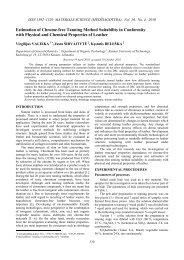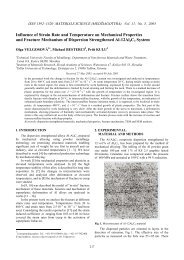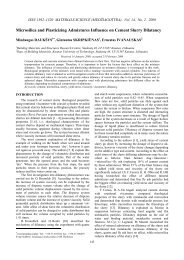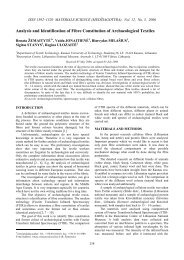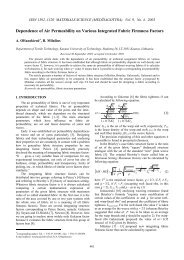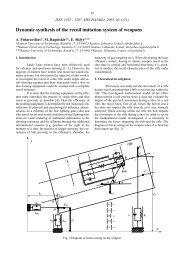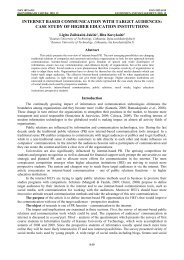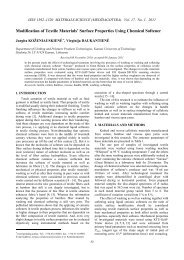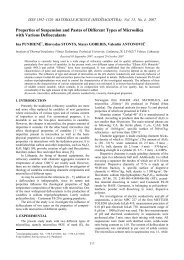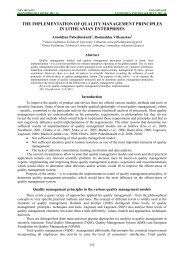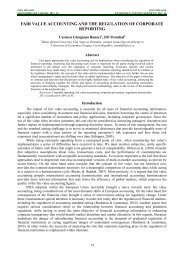Ferrocene Derivatives in Boundary Lubrication - Kaunas University ...
Ferrocene Derivatives in Boundary Lubrication - Kaunas University ...
Ferrocene Derivatives in Boundary Lubrication - Kaunas University ...
Create successful ePaper yourself
Turn your PDF publications into a flip-book with our unique Google optimized e-Paper software.
63<br />
ISSN 1392 - 1207. MECHANIKA. 2006. Nr.2(58)<br />
<strong>Ferrocene</strong> derivatives <strong>in</strong> boundary lubrication<br />
H. P. Janecki<br />
Technical <strong>University</strong> Radom, Chrobrego 27, 26-600 Radom, Poland, E-mail: Hieronim.Janecki@pr.radom.pl<br />
1. Introduction<br />
Most of the publications deal<strong>in</strong>g with organometallic<br />
additives discuss metal dialkyldithiophosphates [1,<br />
2]. The exceptions are organometallic t<strong>in</strong> and iron compounds<br />
used <strong>in</strong> laboratory and model <strong>in</strong>vestigations as friction<br />
modifiers and k<strong>in</strong>ematics’ pair surface modifiers [3,<br />
4]. The <strong>in</strong>vestigation results of the <strong>in</strong>teraction of carboxylic<br />
acids with the surface dur<strong>in</strong>g friction seem to be quite <strong>in</strong>terest<strong>in</strong>g.<br />
This k<strong>in</strong>d of study has rarely been reported <strong>in</strong><br />
tribological literature with<strong>in</strong> the last 15 years [5].The results<br />
of the latest <strong>in</strong>vestigation of materials of peculiar future<br />
usage, as well as limit<strong>in</strong>g energy losses caused by friction<br />
and wear lay foundation of the present progress <strong>in</strong><br />
mach<strong>in</strong>e build<strong>in</strong>g. Already <strong>in</strong> 1966, it was estimated that<br />
approximately 30 % of raw materials used <strong>in</strong> the process<br />
were lost due to wear [6]. The loss of materials and energy<br />
may be considerably limited when the materials and lubricants<br />
are appropriately chosen. Attempts to achieve the<br />
best effect made it possible to f<strong>in</strong>d many, but not all, solutions<br />
of the problem [7]. The reason is that mechanical,<br />
physical and chemical processes which take place <strong>in</strong> a friction<br />
pair have not been exam<strong>in</strong>ed and exhaustively described<br />
yet. The development and application of new researches<br />
concern<strong>in</strong>g k<strong>in</strong>etics, as well as friction and wear<br />
mechanisms, have great impact on surface durability of<br />
mach<strong>in</strong>e elements. Therefore, it is important to precisely<br />
exam<strong>in</strong>e mechanisms which govern the behaviour of lubricants<br />
and additives <strong>in</strong> boundary friction conditions. Our<br />
researches aim at present<strong>in</strong>g relationships between various<br />
media <strong>in</strong> friction processes <strong>in</strong> order to characterise those<br />
processes. It is known that lubricant oils without additives<br />
are <strong>in</strong>sufficient because they do not m<strong>in</strong>imalise friction and<br />
wear of work<strong>in</strong>g elements [8]. In modern constructions,<br />
friction pairs that resist extreme loads are applied. Thus,<br />
the demand of new, synthetic additives still <strong>in</strong>creases,<br />
s<strong>in</strong>ce the additives complement basic lubricants [9-11].<br />
Scientific literature proves that the creation of the surface<br />
layer has crucial impact on the friction and wear processes<br />
[12]. Among numerous additives undergo<strong>in</strong>g exam<strong>in</strong>ation,<br />
ferrocene derivatives evoke the greatest <strong>in</strong>terest as the potential<br />
modifiers, although their properties, as well as<br />
probable possibility to create protective layers on friction<br />
surfaces have not been exhaustively discussed so far. Relatively<br />
high thermal stability, the presence of metal <strong>in</strong> the<br />
‘sandwich’ structure, and first and foremost possibility of<br />
numerous ferrocene modifications let us expect to obta<strong>in</strong><br />
some <strong>in</strong>terest<strong>in</strong>g and profitable phenomena on the friction<br />
surface. This is the reason why ferrocene derivatives are<br />
the objective of this paper.<br />
Project aim and subject. The subject of this paper<br />
is the selected results from the studies on the evaluation of<br />
the effect of some paraff<strong>in</strong> oil based liquid lubricants<br />
modified with ferrocene derivatives upon friction surface<br />
modification.<br />
The effect of lubrication on wear. Senatorski's<br />
studies have shown that there is an important <strong>in</strong>fluence of<br />
oil viscosity on wear rate <strong>in</strong> the conditions of analysis of<br />
wear resistance of carburized, nitrided and chromiumplated<br />
layers [13]. One should also keep <strong>in</strong> m<strong>in</strong>d adsorption<br />
– the first <strong>in</strong>itial stage of lubricant - surface <strong>in</strong>teraction<br />
which often determ<strong>in</strong>es both the type and course of friction<br />
and the character of wear changes. Both the above considerations<br />
and mathematical models are developed with the<br />
aim of underl<strong>in</strong><strong>in</strong>g the effect of lubricant – friction pair<br />
surface <strong>in</strong>teraction on the performance of friction pairs<br />
dur<strong>in</strong>g operation.<br />
2. Experimental<br />
2.1. <strong>Ferrocene</strong> derivatives. Wear tests<br />
From among <strong>in</strong>terest<strong>in</strong>g and effective compounds,<br />
the follow<strong>in</strong>g compounds have been chosen: 1,1'dialkyl-<br />
2thia [3] ferrocenophane 1SJ -4SJ, see Fig. 1.<br />
CH3 H<br />
C<br />
H<br />
Fe H S<br />
C<br />
H<br />
1S 2S<br />
C2H5 C<br />
H<br />
Fe H S<br />
C<br />
C2H5 3S 4S<br />
C<br />
H<br />
Fe H S<br />
C<br />
CH 3<br />
C6H5 C<br />
H<br />
Fe H S<br />
C<br />
C6H5 Fig. 1 Structure of searched 1,1'dialkyl-2thia [3] ferrocenophane<br />
In order to f<strong>in</strong>d the most appropriate work conditions,<br />
the <strong>in</strong>fluence of concentration onto the wear scar<br />
diameter was <strong>in</strong>vestigated on the basis of unsubsidized<br />
ferrocene = FcH and 3SJ compound see Fig. 2.<br />
In the next tests the follow<strong>in</strong>g 1,1'diethyl-2thia [3]<br />
ferrocenophane 3SJ and wear tests have been chosen for<br />
the further study, see Fig. 3.
wear scar d , mm<br />
4<br />
3<br />
2<br />
1<br />
0<br />
0.1 0.3 0.5 1 1.6 2<br />
concentration c*0.25<br />
Fig. 2 Influence of concentration onto the wear FbA - test,<br />
solutions <strong>in</strong> white oil<br />
C2H5 C<br />
H<br />
Fe H S<br />
C<br />
C 2H 5<br />
b<br />
Fig. 3 Tested model systems: a - molecular structure of<br />
tested 1,1'diethyl-2thia [3] ferrocenophane;<br />
b - ZA – 2 Ball on cyl<strong>in</strong>der configuration<br />
2.2. Model wear tests - Test ZA-2<br />
The tests were performed us<strong>in</strong>g Tribometer ZA-2<br />
designed by Drechsler et al. specifically for the study of<br />
additives and lubricants [14]. Additionally, a friction pair<br />
of similar dimensions made of bear<strong>in</strong>g bronze B1010 was<br />
designed. The lubricat<strong>in</strong>g agent was a solution of 1,1'diethyl-2-thia<br />
[3] ferrocenophane sulphide (3SJ) of<br />
0.025 mole/dm 3 concentration <strong>in</strong> paraff<strong>in</strong> oil. The 3SJ sulphide<br />
exhibited the highest reactivity towards the surface<br />
tested [4]. After the tests had been completed, the surfaces<br />
of the balls were analysed us<strong>in</strong>g an optical microscope. A<br />
wear scar of a*b 2.57 * 2.38 mm with wear volume<br />
VV = 0.7 * 10 -3 mm 3 was recorded for the steel 100Cr6 k<strong>in</strong>ematic<br />
pair at the load of 31 N. The <strong>in</strong>itial traces of reaction<br />
layers formed were observed <strong>in</strong> the polarized light<br />
under the microscope at the load of 50 N. Selected measurement<br />
results obta<strong>in</strong>ed for a solution of 3SJ sulphide are<br />
given <strong>in</strong> Table 1.<br />
Keep<strong>in</strong>g <strong>in</strong> m<strong>in</strong>d the division of friction conditions<br />
depend<strong>in</strong>g on the friction coefficient determ<strong>in</strong>ed [15],<br />
it becomes clear that the experiments were carried out under<br />
boundary friction conditions. Thus, operat<strong>in</strong>g condi-<br />
a<br />
FcH<br />
3SJ<br />
64<br />
Table 1<br />
Selected results of wear measurements carried out us<strong>in</strong>g<br />
Tribometer ZA-2<br />
Load, N Wear V *10 -3 , mm 3 m (time 1s) m (time 3s)<br />
10 0.24 0.2 0.07<br />
30 0.7 0.20 0.127<br />
50 1.3 0.19 0.128<br />
70 2.20 0.183 0.123<br />
90 2.40 0.177 0.122<br />
110 2.60 0.186 0.127<br />
tions of tribometer ZA-2 are suitable for our observation<br />
purposes and for the evaluation of the effect of liquid lubricants<br />
on friction surface modification. The formation of<br />
reaction layers and their <strong>in</strong>fluence on friction coefficient<br />
reduction were observed throughout the <strong>in</strong>vestigations. The<br />
third column <strong>in</strong> Table 2, which illustrates the change <strong>in</strong><br />
friction coefficient with<strong>in</strong> the first second of tribometer<br />
ZA-2 operation, seems to be <strong>in</strong>terest<strong>in</strong>g <strong>in</strong> the light of theoretical<br />
considerations. It should be noted that start<strong>in</strong>g from<br />
a load of 50 N the system moves with<strong>in</strong> the first second of<br />
operation beyond the boundary friction area towards dry<br />
friction *> 0.15, but with<strong>in</strong> the third second it returns to<br />
the boundary friction area. And so we are back with the<br />
motto of this project "the first seconds and m<strong>in</strong>utes of the<br />
friction pair's motion are the most important ones". Figs. 4-<br />
5 show pictures of the surfaces exam<strong>in</strong>ed, Fig. 7 gives the<br />
analysis results. Reaction layers can be clearly seen nonuniformly<br />
arranged on the surfaces of the balls tested.<br />
Fig. 4 Wear scar SEM image after ZA-2 test, N = 50 N,<br />
*= 0.096, t = 3 m<strong>in</strong><br />
Fig. 5 Wear scar SEM image after ZA-2 test, N = 50 N,<br />
*= 0.096, t = 3 m<strong>in</strong>, wear scar center
A skillful design of a system that will work properly<br />
s<strong>in</strong>ce the startup guarantees cont<strong>in</strong>uous, and successful<br />
failure-free operation. To satisfy this condition it is important<br />
at the friction pair design stage to choose appropriate<br />
materials treat<strong>in</strong>g lubricant as a component of the same<br />
importance as the materials selected for the k<strong>in</strong>ematic pairs<br />
be<strong>in</strong>g designed. Currently available results of <strong>in</strong>vestigations<br />
of sulphur ferrocene derivatives <strong>in</strong>dicate a possibility<br />
to generate the mixed organic-<strong>in</strong>organic layers on friction<br />
surfaces. Fig. 6 shows the enlarged image of a wear scar<br />
with the traces of reaction products on the surface.<br />
Fig. 6 Enlarged SEM image of wear scar after ZA-2 test,<br />
N = 50 N, *= 0.096, t = 3 m<strong>in</strong>, reaction products<br />
are seen along friction path<br />
Fig. 7 SEM and Results of steel 100Cr6 surface analysis<br />
obta<strong>in</strong>ed us<strong>in</strong>g an EDS analyzer<br />
It is assumed that a k<strong>in</strong>ematic pair should be<br />
matched properly to ensure failure-free mat<strong>in</strong>g of its elements<br />
for as long as possible. EDS studies were carried out<br />
to analyse SEM recorded reaction layers be<strong>in</strong>g generated<br />
on the surface of a k<strong>in</strong>ematic pair. The results are shown <strong>in</strong><br />
Fig. 6. It is difficult to model and analyse the <strong>in</strong>teractions<br />
of ferrocene iron and ferrocene sulphur with a steel friction<br />
surface. It is not possible to dist<strong>in</strong>guish the com<strong>in</strong>g from<br />
alloy iron signals from those com<strong>in</strong>g from ferrocene iron<br />
without us<strong>in</strong>g the tracer method. The work [16] shows Auger<br />
spectroscopy analysis results of the surface of a steel<br />
ball tested by means of tribometer ZA-2. The steel surface<br />
analysis results do not contribute any essential new <strong>in</strong>formation<br />
that would help to develop a model. However, very<br />
65<br />
large changes <strong>in</strong> the chemical composition of the steel surface<br />
analyzed were found. The changes appeared when the<br />
sample surface was etched with argon ions for 2 m<strong>in</strong>utes.<br />
In comparison with the chemical composition of steel as<br />
given by Polish Standard, <strong>in</strong>creased chromium and carbon<br />
contents were found after the signal com<strong>in</strong>g from oxygen<br />
had faded. The model surface was changed to record the<br />
presence and to analyse the reaction products be<strong>in</strong>g generated<br />
on the surface <strong>in</strong> the presence of ferrocene derivatives.<br />
Bronze B1010 and copper surfaces were chosen for further<br />
<strong>in</strong>vestigations of ferrocene sulphides under boundary lubrication<br />
conditions.<br />
2.3. Thermal studies <strong>in</strong> the presence of oil solutions<br />
Earlier studies carried out us<strong>in</strong>g the "hot-wire"<br />
method <strong>in</strong>dicated that 3SJ - 1,1'diethyl-2-thia [3] ferrocenophane<br />
was the most reactive compound <strong>in</strong> the conditions<br />
under which tribological experiments and model<br />
thermal tests were performed [17]. Thermal characteristic<br />
of 3SJ are presented <strong>in</strong> Table 2.<br />
Table 2<br />
Characteristic thermal properties determ<strong>in</strong>ed us<strong>in</strong>g the derivatographic<br />
method (DTA)<br />
t.t, K Breakdown temp., K Mass decrement at breakdown<br />
temp., %<br />
325 411 – 553 43.5<br />
The samples used were 1 a bronze B1010 plate<br />
and 2 a polished copper plate. They were dipped <strong>in</strong> an oil<br />
solution and heated <strong>in</strong> a dry<strong>in</strong>g chamber at 411 K for 3<br />
hours. The surfaces of the samples after static-thermal tests<br />
were studied with the naked eye and with a magnify<strong>in</strong>g<br />
glass. After thermal tests the sample surfaces did not<br />
change except sample 1 which was covered with a grey<br />
opalescent bloom of reaction products of the 3SJ solution.<br />
The samples were then analysed by SEM/EDS. Two parallel<br />
tests were made. Samples 1 and 2 were studied immediately<br />
after removal from oil solutions. The surfaces of<br />
samples 3 and 4 were washed with acetone and dried before<br />
analysis.<br />
2.4. Instrumental analysis<br />
Instrumental analysis was performed for the selected<br />
elements of k<strong>in</strong>ematic pairs and representative samples.<br />
The samples analysed were: -1- polished copper plate<br />
surface, -2- polished bronze B1010 plate surface, -3- polished<br />
copper plate surface (washed with acetone), -4- polished<br />
bronze B1010 plate surface (washed with acetone).<br />
Figs. 8 and 9 show surface analysis results obta<strong>in</strong>ed<br />
us<strong>in</strong>g SEM/EDS analysis methods. A review of the<br />
results po<strong>in</strong>ts to the occurrence of <strong>in</strong>terest<strong>in</strong>g <strong>in</strong>teractions<br />
between the surfaces of the samples tested and the solution<br />
of 3SJ <strong>in</strong> paraff<strong>in</strong> oil. This is particularly apparent <strong>in</strong> the<br />
case of sample 1. Sample 1 analysis results are given <strong>in</strong><br />
Table 3.<br />
Simultaneously, DTA analysis was performed for<br />
the samples of powdered iron and copper powder. DTA<br />
thermal effects and recorded TG mass variations observed<br />
<strong>in</strong> the case of the reaction of the 3SJ compound with the<br />
extended surface of iron powder "ferrum reductum" <strong>in</strong>dicated<br />
that chemical changes were tak<strong>in</strong>g place between the
EDS analysis results<br />
Table 3<br />
Element Percentage Percentage Accuracy 3 Constant K<br />
by wt by atom SIGMA<br />
S 9.21 16.73 0.10 0.0514<br />
Fe 0.38 0.39 0.03 0.0046<br />
Cu 90.41 82.88 0.35 0.8867<br />
compounds analysed and the powder surface. The 3SJ<br />
compound - 1,1'diethyl-2-thia [3] ferrocenophane also reacts<br />
<strong>in</strong>tensively with the surface of the copper sample. The<br />
shares of sulphur and iron <strong>in</strong> the grey opalescent reaction<br />
layer reach 9.21 % and 0.38 %, respectively. The image of<br />
a polished copper plate surface obta<strong>in</strong>ed us<strong>in</strong>g an electron<br />
microscope has been shown <strong>in</strong> Fig. 8.<br />
Fig. 8 SEM image of a copper surface tested <strong>in</strong> the solution<br />
of 3SJ sulphide <strong>in</strong> paraff<strong>in</strong> oil at 411 K for 3 hours<br />
Fig. 9 Illustration of the results of EDS analysis of copper<br />
surface shown on Fig. 8<br />
The bronze B1010 surface was studied after friction<br />
by means of scann<strong>in</strong>g electron microscopy and Auger<br />
electron spectroscopy. The <strong>in</strong>vestigation results are shown<br />
<strong>in</strong> Fig. 10.<br />
2.5. Four ball tests<br />
The additional tests were performed us<strong>in</strong>g Fourball<br />
Mach<strong>in</strong>e FbA designed specifically for the study of<br />
additives and lubricants. Exemplary results of friction surfaces<br />
exam<strong>in</strong>ed <strong>in</strong> <strong>Ferrocene</strong> Sulphide solutions and tests<br />
conditions are given below <strong>in</strong> the follow<strong>in</strong>g Figs. 11-18.<br />
66<br />
a<br />
b<br />
c<br />
Fig. 10 SEM image of bronze B1010 surface tested <strong>in</strong> the<br />
solution of 3SJ sulphide <strong>in</strong> paraff<strong>in</strong> oil (a), distribution<br />
of ferrocene iron on the B1010 surface (b),<br />
AES Spectrum (c)<br />
Fig. 11 An example of SEM picture of the pure surface of<br />
ŁH-15 Steel
The surface differentiation is immediately visible,<br />
although the surface was honed and washed with acetone.<br />
For the sake of comparison, the picture of wear scar surface<br />
after FbA test is presented <strong>in</strong> Fig. 12. In the middle of<br />
the wear scar (0.5 mm diameter), along the scan l<strong>in</strong>e, em<strong>in</strong>ent<br />
traces of sulphur are visible. The changes of sulphur<br />
concentration are pictured by the white bend l<strong>in</strong>e across the<br />
wear tracks.<br />
Fig. 12 Wear scar on the worn surface of the exam<strong>in</strong>ed ball<br />
after FbA test; load 5 N; analysed solution of 3SJ<br />
<strong>in</strong> white oil; concentration 0.025 mol/dm 3<br />
The SEM picture of changes on the upper layer of<br />
friction surface <strong>in</strong> the presence of ferrocene sulphide solutions<br />
with various wear scars is presented <strong>in</strong> Fig. 13.<br />
Fig. 13 An example of details of friction surface friction<br />
FbA test, load 10 N; lubricant: 3SJ solution <strong>in</strong><br />
white oil, c = 0.025 mol/dm 3<br />
More obvious <strong>in</strong>stance of surface material after<br />
FbA test is presented <strong>in</strong> Fig. 14. Near the wear scar (<strong>in</strong> the<br />
middle), layers of the reaction products were shown on the<br />
right side of the photograph.<br />
Zoom<strong>in</strong>g of the wear tracks on the friction surface<br />
is presented <strong>in</strong> the Fig. 15. The changes of chemical properties<br />
of analysed surfaces are illustrated by means of char-<br />
67<br />
acteristic l<strong>in</strong>es along the scan l<strong>in</strong>e. The routs of those l<strong>in</strong>es<br />
delimit the changes of sulphur concentration <strong>in</strong> analysed<br />
materials.<br />
Fig. 14 SEM picture of wear scar FbA test, load 10 N; lubricant:<br />
3SJ solution <strong>in</strong> white oil,<br />
c = 0.025 mol/dm 3<br />
Fig. 15 SEM picture of a fragment of reaction layer wear<br />
scar <strong>in</strong> the middle FbA test 10 N; solution of 3SJ;<br />
c = 0.025 mol/dm 3 <strong>in</strong> white oil<br />
In case of higher load, e.g. 20 N, a deformation of<br />
the upper layer is observed <strong>in</strong> the field of wear scar. By<br />
means of SEM, visible deformation of such type is detected<br />
on the surface. Figs. 16 and 17 present the chosen<br />
examples of surface materials.<br />
Fig. 16 SEM picture of wear scar; FbA test, load 20 N,<br />
steel £H-15, solution of 3SJ, c = 0.025 mol/dm 3 <strong>in</strong><br />
white oil<br />
In case of the exam<strong>in</strong>ed solutions of the compound<br />
3SJ (see Fig. 17) various wear scars were registered.<br />
The most <strong>in</strong>terest<strong>in</strong>g result is presented <strong>in</strong> Fig. 18. SEM<br />
picture reveals a wear scar as well as a transfer of the ma-
terial after the tribological test. Reaction layers were observed<br />
which are connected with the friction surface.<br />
Bright layers conta<strong>in</strong><strong>in</strong>g the products of tribochemical reaction<br />
are also em<strong>in</strong>ently visible <strong>in</strong> Fig. 18.<br />
Fig. 17 SEM picture of wear scar; FbA test, load 20 N,<br />
steel £H-15, solution of 3SJ, c = 0.025 mol/dm 3 <strong>in</strong><br />
white oil<br />
Fig. 18 SEM picture of wear scar; FbA test, load 20 N,<br />
steel £H-15, solution of 3SJ, c = 0,025 mol/dm 3 <strong>in</strong><br />
white oil<br />
3. Results<br />
The results of model friction and thermal tests<br />
lead to the conclusion that <strong>in</strong> the conditions studied there<br />
was a reaction between the sulphide tested and the surface.<br />
If there had been unreacted sulphide<br />
(C5H4)2Fe(CHC2H5)2S 1,1'diethyl-2-thia [3] ferrocenophane<br />
left on the surface, the share of sulphur and iron<br />
would have been 10.66 % and 18.66 %, respectively (see<br />
Table 4) because C%S = 9.21 % < 10.66 % and<br />
C%Fe = 0.38 % < 18.66 %.<br />
Table 4<br />
Percent share of sulphur and iron <strong>in</strong> 3SJ sulphide and on<br />
the surface<br />
In compound On surface<br />
C% S C% Fe C% S C% Fe<br />
10.66 18.66 9.21 0.38<br />
It can be concluded that a reaction layer conta<strong>in</strong><strong>in</strong>g<br />
less sulphur and iron than the 3SJ compound is formed<br />
on the surface of the plate tested. Under the experimental<br />
conditions no significant sulphur and ferrocene iron peaks<br />
have been observed on the surfaces of samples 3 and 4<br />
washed thoroughly with acetone. Hence, the <strong>in</strong>teractions<br />
68<br />
observed under the experimental conditions do not lead to<br />
the formation of stable layers comb<strong>in</strong>ed with the surface<br />
be<strong>in</strong>g studied. Additional friction tests on bronze B1010<br />
samples were carried out us<strong>in</strong>g ZA-2 and their surfaces<br />
were analysed by AES. Some of the analysis results are<br />
been given <strong>in</strong> [18] and [20] (see also Fig. 4). The surface<br />
layer of the sample analysed was found to conta<strong>in</strong> an <strong>in</strong>creased<br />
content of sulphur and the presence of iron was<br />
<strong>in</strong>creas<strong>in</strong>g s<strong>in</strong>ce the thirteenth m<strong>in</strong>ute of surface etch<strong>in</strong>g<br />
with a beam of argon ions. The above results confirm the<br />
previously observed tendency of ferrocene sulphur derivatives<br />
to form reaction layers on the surfaces of analysed<br />
samples. On the basis of tribological and chemical research<br />
the follow<strong>in</strong>g mechanism of changes <strong>in</strong> ferrocene sulphur<br />
derivatives was proposed <strong>in</strong> [16], e.g. physical adsorption,<br />
reaction of sulphur with surface metal, also with iron from<br />
a ferrocene derivative, migration of reaction products on<br />
the surface (also <strong>in</strong>to the layer). It follows from the percent<br />
share of sulphur and iron <strong>in</strong> ferrocene derivatives as well<br />
as from spectroscopic analysis of the derivatives that the<br />
reaction layer formed on the surface may be a mixture of<br />
copper sulphides, ferrocene iron and unreacted molecules<br />
of the compound studied. It follows from the basic analytical<br />
discussion with Prof. Ulrich Wendt from IWW Magdeburg<br />
that the surface layer be<strong>in</strong>g discussed and analysed<br />
may be described as shown <strong>in</strong> Table 5.<br />
Sequence of layers and their thickness<br />
Table 5<br />
Type of layer Thickness of layer, µm<br />
External adsorptive 0.0003 – 0.0005<br />
Oxide layer 0.01 – 0.1<br />
Internal polished layer 0.1<br />
Considerable deformations up to 2<br />
Average deformations up to 10<br />
Slight deformations up to 50<br />
Core of the analysed material sample<br />
Electrons with the energy of ~ 25 keV penetrate<br />
the surface to the depth of ~ 1 – 1.5 µm. The X-ray microanalysis<br />
helps to study the composition of surface layers;<br />
the data carrier is characteristic radiation of high-energy<br />
electrons. This method is suitable for the analysis of surface<br />
layers of about 1 µm <strong>in</strong> depth. The depth from which<br />
electrons (resid<strong>in</strong>g <strong>in</strong> the surface layer) can be knocked out<br />
is even smaller and equals 1nm which is equivalent to 2-3<br />
atomic layers at the pressure of 10 -6 - 10 -11 hPa. Our experience<br />
<strong>in</strong> the study of the effetct of the environment on surface<br />
layer formation tells us that it is possible to obta<strong>in</strong> a<br />
maximum amount of data about the surface tested under<br />
boundary lubrication conditions by us<strong>in</strong>g a number of analytical<br />
methods. The methods of ion and electron spectrometry<br />
that are useful <strong>in</strong> this area are given <strong>in</strong> [18]. The<br />
compounds of <strong>in</strong>terest – sulphur derivatives of ferrocene –<br />
<strong>in</strong>teract with the surface of the tested metal samples at a<br />
certa<strong>in</strong> def<strong>in</strong>ed depth. The reaction layer is non-measurable<br />
if its thickness is too small. The reaction layers generated<br />
on bronze B1010 and copper surfaces by a static thermal<br />
method exhibit poor adhesion to the surface and can readily<br />
be removed with polar solvents. The analysis of th<strong>in</strong><br />
monomolecular layers should be carried out us<strong>in</strong>g Auger<br />
Electron Spectroscopy (AES) and X-ray Photoelectron<br />
Spectroscopy (ESCA). Researches confirmed that ferro-
cene derivatives modify tribological properties of lubricants.<br />
Em<strong>in</strong>ent relations between the structure and antifrictional<br />
behaviour were noted. 2-thia [3] ferrocenophanes<br />
show positive antifrictional behaviour <strong>in</strong> wide range of<br />
loads and temperatures. Antifrictional properties of those<br />
compounds improve proportionally to concentration. Introduc<strong>in</strong>g<br />
ferrocene derivatives <strong>in</strong>to base oils results <strong>in</strong> a<br />
shift of maximal conditions of work to the areas of higher<br />
loads. This property dist<strong>in</strong>ctly depends on the structure of<br />
compounds be<strong>in</strong>g exam<strong>in</strong>ed.<br />
References<br />
1. Sieber, I., Meyer, K., Kloss, H. Characterization of<br />
boundary layers formed by different metal dithiophosphates<br />
<strong>in</strong> a four-ball mach<strong>in</strong>e.-Wear 85, 1983, p.43.<br />
2. Mart<strong>in</strong>, J.M. Friction <strong>in</strong>duced amorphisation with<br />
ZDDP an EXAFS study.-ASLE Trans. 29, 4, p.523.<br />
3. Ozim<strong>in</strong>a, D., Kajdas, Cz. Tribological properties an<br />
action mechanism of complex compounds of Sn(II) and<br />
Sn(IV) <strong>in</strong> lubrication of steel.-ASLE Trans. 30, 4, 508.<br />
4. Janecki, H.P., Ozim<strong>in</strong>a, D. Die Eigenschaften der <strong>in</strong><br />
Ferrocenlösungen entstandenen Grenzfilme.-Int. Conf.<br />
Tribologie 2000, 14-18 Jan. 1992.<br />
5. Hu Zu-Shao, Hsu, S., Wang Pu Sen. Tribochemical<br />
reaction of stearic acid on copper surface studied by<br />
surface enhanced raman spectroscopy.-Tribology<br />
Transactions, 35, 1992, 3, 417.<br />
6. Jost H.P. <strong>Lubrication</strong> Tribology. Education and Research.<br />
A Report on the Present Position and Industry’s<br />
Need’.-London: H.M. Stationary Office 1966.<br />
7. Kimura, Y., Okabe, H. The current state of tribology<br />
<strong>in</strong> Japan.-Tribology International 1993, 26, 4, 275-283.<br />
8. Aswith, T.C., Cameron, A., Croud, R.F. Cha<strong>in</strong> of<br />
additives <strong>in</strong> relation to lubricants <strong>in</strong> th<strong>in</strong> films and<br />
boundary lubrication.-Proc. Royal Society, 1966, v.A,<br />
291, p.500.<br />
9. Lara, J., Kotvis, P.V., Tysoe, W.T. The surface chemistry<br />
of chlor<strong>in</strong>e and sulphur conta<strong>in</strong><strong>in</strong>g extremepressure<br />
lubricant additives.-Proc. of the 2nd Symposium<br />
15-17 September 1997, <strong>University</strong> of Łódź, Polish<br />
Tribology Society, p.79.<br />
10. Materials from Report of Japan Mach<strong>in</strong>ery Federation<br />
1982 "Research on the Standardization of Technology<br />
of Energy Conservation".<br />
11. Studt, P. <strong>Boundary</strong> lubrication: adsorption of oil additives<br />
on steel and ceramic surfaces and its <strong>in</strong>fluence on<br />
friction and wear.-Tribology International, April 8-9<br />
v.22, No2, p.111-119.<br />
12. Płaza S. Fizykochemia procesów Tribologicznych.<br />
Wydawnictwo Uniwersytetu Łódzkiego, 1997.<br />
13. Senatorski, J. Evaluation of the heat treatment effect<br />
of the nitride layer on tribological properties of carbon<br />
steels.-Tribologia 3’94(135), 310.<br />
14. Drechsler G., Haupt H. Schmierungstechnik 15 1984,<br />
6, s.169-172.<br />
15. Bowden, F.P., Tabor, D. The Friction and <strong>Lubrication</strong><br />
of Solids.-Oxford Un. Press 2001.<br />
16. Janecki H. P. Ph D Thesis ICh i TJ Warszawa 1989 r.<br />
17. Janecki, H.P., Janecka, M., Müller, H.G., Wendt, U.<br />
–Tribologia, 1995, 4, p.320-358.<br />
18. Brune D. et all. Surface Characterisation a User’s<br />
Sourcebook.-Willey-VCH, 1997.<br />
69<br />
H. P. Janecki<br />
FEROCENO DARINIAI ESANT RIBINIAM TEPIMO<br />
SLUOKSNIUI<br />
R e z i u m ė<br />
Nagr<strong>in</strong>ėjant vieną iš reaktyviųjų – ferocenų 1,1<br />
dietyl-2-triferocelofana buvo atlikti term<strong>in</strong>iai tyrimai ir<br />
tr<strong>in</strong>ties modeliavimas. Tr<strong>in</strong>ties modelio dėka gautų tyrimo<br />
rezultatų analizė parodo didelį sieros geležies ir feroceno<br />
geležies reaktyvumą, sąveikaujant su band<strong>in</strong>ių paviršiumi.<br />
Feroceno dar<strong>in</strong>ių reakcijos produktų buvimas metal<strong>in</strong>ių<br />
band<strong>in</strong>ių paviršiuje patvirt<strong>in</strong>tas <strong>in</strong>strument<strong>in</strong>iais analit<strong>in</strong>iais<br />
metodais.<br />
H. P. Janecki<br />
FERROCENE DERIVATIVES IN BOUNDARY<br />
LUBRICATION<br />
S u m m a r y<br />
Model friction and thermal <strong>in</strong>vestigations have<br />
been carried out to study the most reactive of the ferrocene<br />
derivatives tested so far - 1,1' diethyl-2-thia ferrocenophane.<br />
The analysis of the results obta<strong>in</strong>ed from model<br />
friction <strong>in</strong>vestigations po<strong>in</strong>ts to the reactive character of<br />
both sulphur and ferrocene iron <strong>in</strong> reactions with the surfaces<br />
of the samples tested. The presence of ferrocene derivative<br />
reaction products on the surface of the metal samples<br />
studied has been confirmed by means of <strong>in</strong>strumental<br />
analytical methods.<br />
Г. П. Янецки<br />
СТРОЕНИЯ ФЕРОЦЕНОВ ПРИ ГРАНИЧНОЙ<br />
СМАЗКЕ<br />
Р е з ю м е<br />
При исследовании одного из реактивных фероценов<br />
– 1,1 диетилтрифероцелофана были применены<br />
термические методы и фрикционная модель. Данные,<br />
полученные при исследовании, показывают реактивность<br />
железа серы и железа фероцена, при работе в<br />
паре с образцами. Наличие продуктов реакции строений<br />
фероцена на поверхности металлических образцов<br />
подтверждаются инструментально - аналитическими<br />
методами.<br />
Received August 08, 2005



